Native and introduced fish abound in Reno-Tahoe area waters.
Snow melts high in the Sierra Nevada backcountry, flooding meadows, snaking through creeks, and filling hundreds of high alpine lakes. In the Tahoe Basin, water flows down 63 tributaries into Big Blue, exiting the lake solely through the Truckee River, where it fills downstream reservoirs, boosts the Carson River, and terminates in Pyramid Lake. Farther north, the Humboldt River traverses The Silver State westward, forking into smaller rivers and creeks in all directions. These watersheds, among numerous other waterways, are home to hundreds of fishes — both native and non-native — that supply the reels of Northern Nevada and California’s avid anglers. From the slowly reviving population of native Lahontan cutthroat trout to the introduced smallmouth bass, there’s a wide variety to fish across the region, whether you’re in it for the sport or the culinary reward.
Keep It Local
For nearly three decades, understanding and preserving the biodiversity of Nevada and California’s waterways has been a driving force for Sudeep Chandra, a professor of limnology in the biology department at the University of Nevada, Reno, and director of the university’s Global Water Center.
“There’s a big diversity of fishes in Nevada, from small to really big, from migratory to staying in place, and then from bottom feeders all the way up to top predators,” Chandra explains. “We have fishes that can include everything from the salmonid fishes, like the Lahontan cutthroat trout, all the way to the old archaic and ancient fishes like sturgeon, which used to be here in Northern Nevada, down to the more bottom feeders or suckers. And then, lastly, some of the more interesting [species] that we can also highlight would’ve been things like pup fishes or the smaller fishes that might live in springs, particularly in Southern and Central Nevada.”
Throughout Nevada, there are around 50 freshwater native fishes, and in neighboring California, there are about 70. Add in introduced and invasive fishes, and those numbers roughly double.
Degradation of habitat from dams and fluctuating water levels plus competition from non-native species have undoubtedly had a negative impact on the two states’ native fish populations, however.
In Lake Tahoe, for example, a team of researchers led by Chandra found a tenfold decrease in native fish densities from 1960 to 2011. Starting in the 1800s, rainbow, brown, and brook trout all were introduced to Tahoe for sportfishing, while mackinaw, also called lake trout, were added to the lake in the early 1900s. By the late 1930s, the native Lahontan cutthroat trout was thought to be gone for good, outcompeted by the sharp-eyed mackinaw. Soon after, kokanee salmon began proliferating in Tahoe following a spill into the lake from a north shore hatchery in the 1940s.
In the South Shore Tahoe Keys neighborhood, once home to Tahoe’s largest filtration system, the Upper Truckee Meadow, the man-made lagoons became ground zero for invasive plants and fishes. Predatory, introduced warmwater species such as the large- and smallmouth bass, crappie, bluegill, and catfish have been linked to declining levels of native Lahontan redside shiner and Lahontan tui chub, according to the United States Forest Service Lake Tahoe Basin Management Unit.
“[Environmental] agencies do not have a biological monitoring program up at the lake. So we actually do not know what the current status is of the native fishes. We presume that there’s still a major decline in the numbers since the 1960s. There’s no reason to suspect that they’ve gone up,” Chandra explains. “The good news is there’s still a whole complement of those other fishes in [lakes we’ve studied, including Donner, Cascade, and Fallen Leaf]. Our mountain lakes seem resilient in a way that suggests that the species are still there. However, in the big lakes like Lake Tahoe, there is a decline of those fishes. And the question becomes how long they’ll persist, whether they’ll make it through all the new changes that are happening in the ecosystem, and we just don’t know.”
Chandra will be part of a panel discussion on the status of Nevada’s native fishes, hosted by the Nevada Historical Society, alongside Zeb Hogan, host of National Geographic’s Monster Fish, and graduate student Zach Bess, on June 1.
Upstream Battle
Fortunately, Tahoe and its downstream waterways also are a part of a conservation story that shows that, in some cases, environmental wrongs can be righted.
For hundreds of years, the Lahontan cutthroat trout was the top predator found swimming in Tahoe, the lakes and streams of the Sierra Nevada, and down the Truckee River into Pyramid Lake. But by the 1940s, the trout, recognizable by the slash of red across its throat, was thought to be extinct.
The beginning of the end for the Lahontan cutthroat trout was the discovery of the Comstock Lode in 1859, which brought with it the clear-cutting of Tahoe’s forests, dropping sawdust and eroded soil into the pebbly bottomed streams of the trout’s breeding grounds. As populations grew in the West, the Lahontan cutthroat — with their salmon-like flavor — were harvested in great numbers and sent to restaurants in San Francisco and back east. And in the 1900s, the Derby Dam was constructed on the Truckee River to divert water into the Carson River watershed for agricultural irrigation, drastically lowering the water level of Pyramid Lake and preventing the fish from swimming upstream to its cooler water spawning grounds. The final blow came with the introduction of the lake trout in Tahoe, which could easily outhunt the LCT.
But in the 1970s, a fish biologist found a trout believed to be the Lahontan cutthroat in a remote stream called Pilot Peak, near the Nevada-Utah border. In 1995, the Lahontan National Fish Hatchery, run by the U.S. Fish and Wildlife Service, began raising and researching the discovered trout, but testing wasn’t yet available to confirm the theory. Finally, in the early 2000s, Mary Peacock, an associate professor of biology at UNR, developed a technique to compare DNA samples from the trout found in Pilot Peak to Lahontan cutthroat trout mounted in museums dating as far back as 1872. They were a match.
In 2006, the Pyramid Lake Paiute Tribe, in partnership with the USFWS, began stocking the Lahontan cutthroat trout back into its native waters of Pyramid Lake. Thirteen years later, stocking began in Lake Tahoe. Thanks to a fish bypass installed by the U.S. Bureau of Reclamation and USFWS at Derby Dam in 2001, the trout could once again swim upstream from Pyramid Lake, but it wasn’t until 2021 that a fish screen was installed that prevented the trout from going into the too-warm waters of the Truckee Canal, which flows into the Lahontan Reservoir. The historic spawning journey along the Truckee River between Pyramid Lake and Tahoe was once again possible.
Slowly but surely, the Lahontan cutthroat trout are swimming back from extinction, and this fact carries more significance for one group above the rest.
Kooyooe Tukadu (Cui-ui Eaters)
For centuries, life for the Pyramid Lake Paiute Tribe was sustained by the fish found in Kooyooe Pa’a Panunadu (Cui-ui Standing Water), the slightly salty lake later named in English for its pyramid-shaped limestone structure.
Members of the tribe referred to themselves as Kooyooe Tukadu, or cui-ui eaters, for their dependence on the large sucker fish endemic to Pyramid Lake. The Lahontan cutthroat trout, or agi, also was a central part of their diet. Today, the tribe raises and releases both fish at the Pyramid Lake Fisheries, bolstering the natural growth of the populations. Welcoming visitors onto tribal land to enjoy the fishing opportunities at Pyramid Lake has created jobs and entrepreneurial opportunities for tribal members, too.
For as long as she can remember, Autumn Harry, a member of the Pyramid Lake Paiute Tribe, has been fishing at Pyramid Lake.
“My people are fisher people. My ancestors and the generations before me have been eating and caring for the fish for time immemorial,” Harry explains. “And I think it was really important for my parents as I was growing up for me to be connected to our fish … I’m still very connected to the fish. Because I had that upbringing, I’m fortunate to understand how important it is for my generation to continue caring for the fish.”
Harry is a graduate student at UNR currently finishing up her dissertation on Paiute place names. This year marks the third season of running her fishing guide company, Kooyooe Pa’a Guides.
“I grew up using the spin rod and only within the last five or six years learned how to fly fish. But I realized very quickly that fly fishing is not an accessible industry at all, and it’s not an accessible sport, especially for Native communities,” Harry notes. “During the pandemic, when the tribe decided to close the lake to the public, I would go out with my friends and family and teach them how to fly fish. I recognized the importance of having Indigenous peoples in that role of being a guide, but also especially Indigenous women, who can teach other women or other Native peoples or other communities who have been overlooked within the industry altogether.”
Harry has guided anglers from around the country and as far away as New Zealand. She believes it’s just as much her job to educate her clients on the land, her people, and the work going into reviving the fish populations as it is to help them land hefty cutthroats.
“When people are able to actually catch fish and hold them, knowing the history of it all, I just feel like it helps their appreciation grow even more and really adds to that experience,” Harry says.
Boat fishing is popular at Pyramid, but you’ll also find the shores dotted with fly fishermen and others farther out in the lake perched on ladders with custom-made seats to reach the sharp drop-offs where the large cutthroat like to feed.
Though anglers are allowed to keep a certain number of Lahontan cutthroat trout for consumption, the cui-ui was the first species listed on the Endangered Species list after the act passed in 1973 and has remained there. During spawning, however, the tribe is allowed a special permit to harvest a small number of cui-ui to disperse among the community for cultural reasons, Harry explains. “Any opportunity I have to be outside in my homeland, it’s very healing for me. I have a lot of memories out at the lake, fishing with my late father. When I’m out on the water, I feel like I can connect to all of those things, including my ancestors who came before me,” Harry says. “It reminds me to always be grateful and thankful for all of the love that they put into caring for the land and the water and for our communities, because if they didn’t protect it, I wouldn’t even have the opportunity to be here and to fish for our traditional foods.”
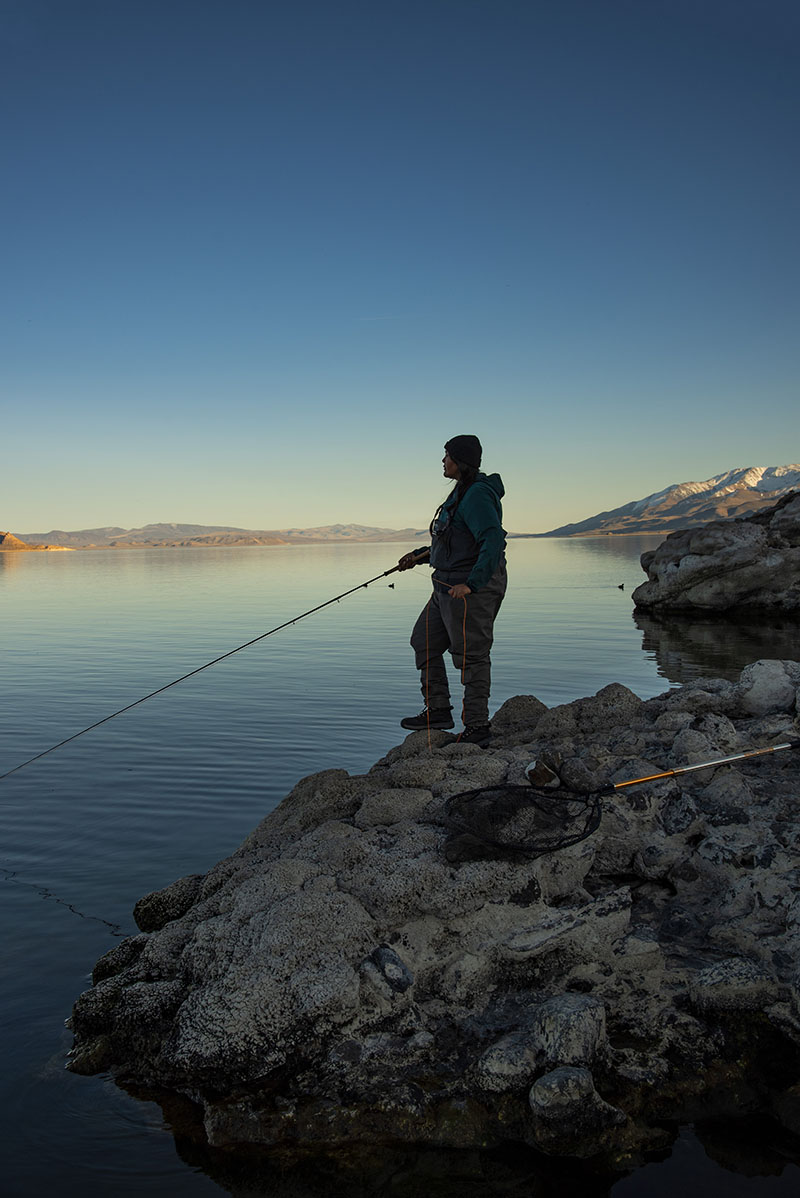
Though traditionally the Paiute dried their fish before eating it, Harry likes to use a modern-day smoker. She prefers the taste of smaller LCT, around 17 to 20 inches, and brines the filets in a salty-sweet mixture before smoking them with alder wood. Alternatively, Harry uses her mother’s recipe (recipe below) to stuff a whole trout with onions and peppers, drizzle with butter and lemon, and pop on the grill or in the oven.
Explore More
Though Pyramid Lake certainly ranks high in many anglers’ books, there are well-stocked waterways to explore in all corners of Reno-Tahoe.
For 15 years, Fallon native Denis Isbister has been traveling the world sharing his fishing escapades on the TV show Wild Fish Wild Places. (Find episodes on World Fishing Network, Prime Video, YouTube, and MyOutdoorTV.) He’s hooked vampire fish in Colombia, caught peacock bass from the Amazon River, and reeled in native rainbow trout in Russia. But when it comes to angling in Nevada, it’s all about the trout.
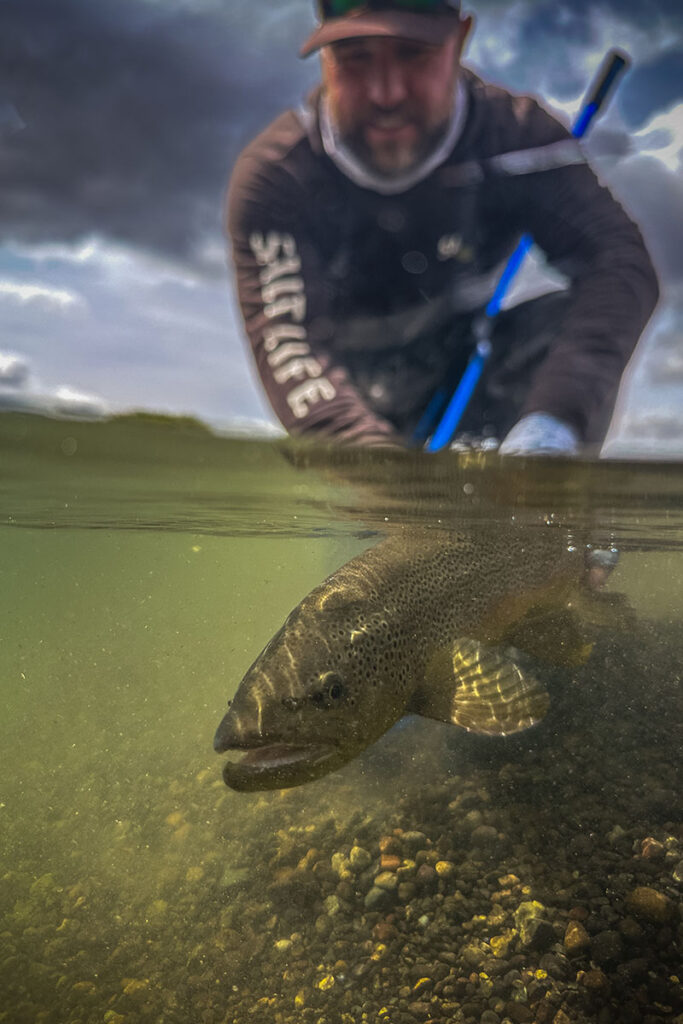
“Lahontan cutthroat trout are the native species for the Great Basin area, and that’s what we chase out there — the trophy Lahontan cutthroat trout with the goal there being something around 15 to 20-plus pounds,” Isbister notes.
Other favorite fishing holes for Isbister are South Fork Reservoir and Wild Horse Reservoir for rainbow trout.
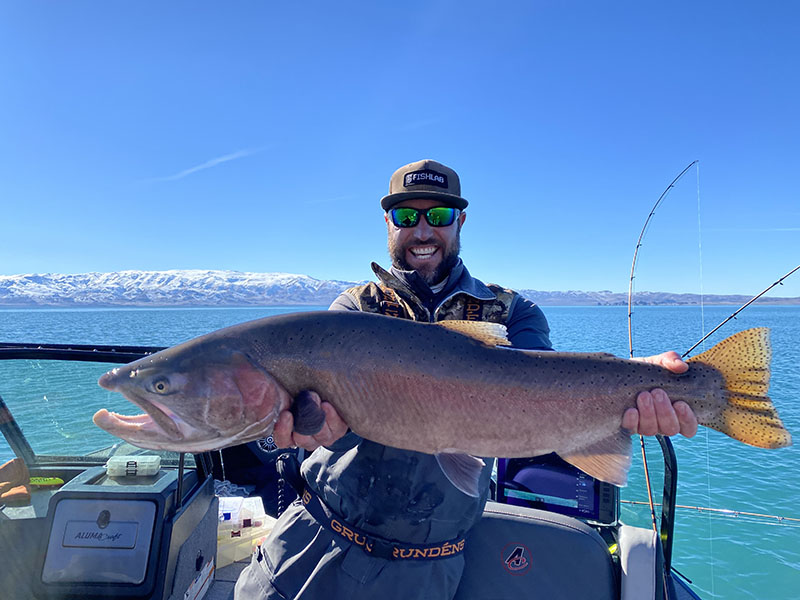
“There are two things about Nevada: One, when we have water, we grow big fish. When the conditions are right, we grow big trophy trout,” Isbister says. “And two, we’re spoiled in Nevada with the lack of crowds.”
When it comes to preparing local trout, Isbister credits the culinary prowess of Steve Hernandez, co-owner/chef of The Slanted Porch in Fallon, who crafts a trout almondine with asparagus risotto that is “to die for,” Isbister says (recipe to follow).
“Most of the fish that I do keep would be white fish, and I make fish tacos. Sometimes if my wife and I are up north in Elko and fly fishing there, we’ll catch smallmouth bass. They have really good flaky meat and make amazing fish tacos,” Isbister says.
For an easy take on tacos, Isbister filets and cuts the bass into cubes and adds it to a tinfoil boat with olive oil and McCormick Street Taco Baja Fish Seasoning Mix. He puts the boat on the grill for roughly 10 minutes while he adds avocado, sour cream, and ranch seasoning to a mixer for the cabbage slaw dressing. After deep frying the corn tortillas in avocado oil, he heaps them with fish, slaw, black beans, and roasted corn. (For more on fish tacos, see “Fresh Favorite” in this issue.)
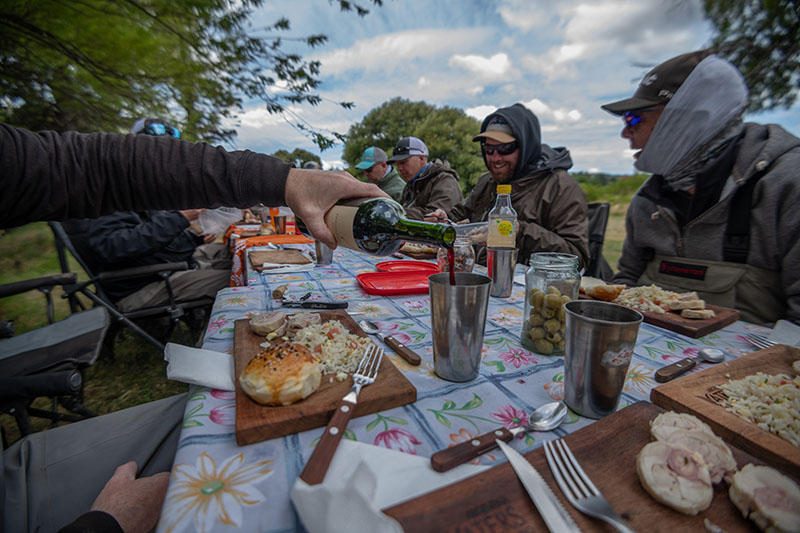
When it comes to dipping your toe into angling, Isbister recommends setting yourself up for success by starting with well-stocked bodies of water.
“Pyramid is a great place to go, but it’s pretty technical,” Isbister says. “Some of the Eastern Sierra lakes like Davis Lake and Frenchman reservoir, as well as the Carson River where it comes out in Gardnerville — those are some high-success areas with lots of planter rainbow trout. If you are going to make a trip out east, there is Kingston reservoir and South Fork Reservoir — all of those places are planted [with fish] regularly, and they are pretty-easy-to-catch fish.”
For fishing expertise in Lake Tahoe, book a chartered boat out of the Ski Run Marina with Tahoe Sport Fishing and catch mackinaw, kokanee salmon, and brown and rainbow trout year-round. The fleet of six boats can accommodate groups of all sizes. If you’re keen on eating your catch but not cooking it up, nearby MacDuff’s Pub in South Lake Tahoe will take the fish and prepare it three ways: beer battered with house-made tartar sauce, blackened with a zesty remoulade, and sautéed with a cream sherry dill sauce.

But you don’t have to trek into the backcountry or rent a boat to get into fishing, explains Zac Campbell, conservation education supervisor at Nevada Department of Wildlife.
“The Truckee River is a world-class rainbow trout and brown trout fishery. It also has mountain white fish in it, which is a native fish. It’s not always the easiest place to fish, but it has trout of all sizes, including trophy-sized trout. The USFWS stocks it with Lahontan cutthroat trout,” Campbell says.
The Sparks Marina also is an underrated fishing hole, Campbell adds. NDOW stocks the lake with trout, smallmouth bass, and channel catfish, which all are safe to eat.
Whether you’re angling for a brag-worthy mackinaw from the depths of Lake Tahoe or a small-but-tasty rainbow trout plucked from the Carson River, there are fishes aplenty across Reno-Tahoe if you know where to look. Fish on!
Know Before You Go
- In Nevada and California, anglers are required to secure fishing licenses, including youths 12 years and older in The Silver State and 16 years and older in The Golden State. Purchase at Ndow.org or Wildlife.ca.gov.
- With a year-round fishing season, the daily limit for the Western Region of Nevada is five trout, five mountain whitefish, and 15 warmwater game fish, of which no more than five may be black bass and five may be walleye (numerous special regulations exist for specific bodies of water, so check NDOW ahead of time). The possession limit is two times the daily limit for the water in which the fish are caught. Visit Fish.wildlife.nv for an interactive map containing all 533 fishable bodies of water across the state.
- For an easy-to-use guide for freshwater fishing regulations in California, visit Apps.wildlife.ca.gov/sportfishingregs for an interactive map with details on each body of water’s fishable species and restrictions.
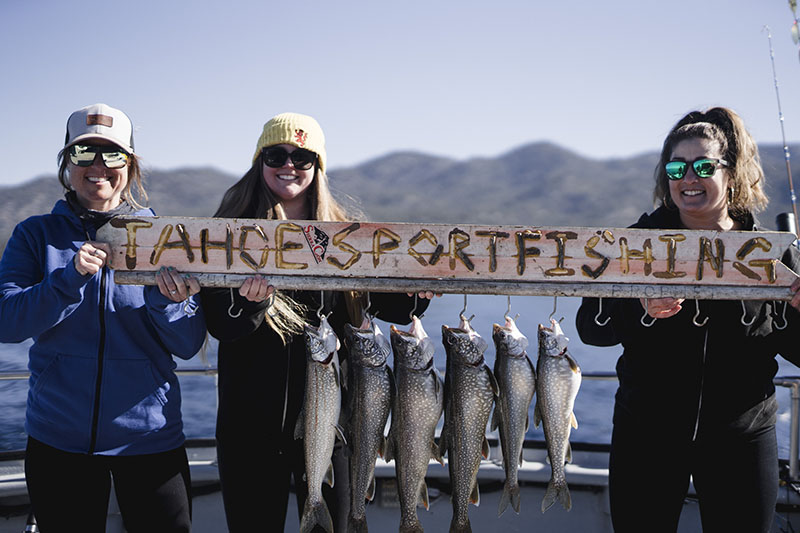
Dip Your Toe In
Interested in getting involved in fishing?
Book a half or full day at Pyramid Lake with Autumn Harry, owner of Kooyooe Pa’a Guides, and at Kooyooepaaguides.com.
NDOW hosts several events throughout the spring and summer for anglers of all ages. Here are a few to consider:
Kids Carp Derby
Sat., June 1, 8 a.m. – 11 a.m.
Sign up at Ndow.org for the annual fishing experience at Lahontan Reservoir that gives young people the opportunity to reel in carp, a species introduced across the U.S. in the 1800s, as well as receive fishing instruction and win prizes. (Note: Fish caught in Lahontan Reservoir are not for consumption due to high mercury levels, nor, frankly, would we recommend eating carp in general.)
Nevada Free Fishing Day
Sat., June 8
Every year on the second Saturday of June, Nevada offers a day when no fishing licenses are required for adults and children alike. At the Sparks Marina, children can attend a free fishing event, from 8 – 11 a.m., when poles and bait are provided, while supplies last.
Introduction to Fly Fishing
Twice a month, NDOW hosts a three-day introduction to fly fishing course, one held in Gardnerville and another female-focused class in Reno. The course starts in the classroom then moves to lake and river settings for hands-on experiences. All equipment is provided. For upcoming dates and registration, visit Ndow.org.
California Free Fishing Days
Sat., July 6 and Sat., Aug. 31
Enjoy two no-permit-required days of fishing during the summer on these free fishing days offered by the California Department of Fish and Wildlife.
Pepper and Onion-Stuffed Lahontan Cutthroat Trout
(courtesy of Beverly Harry, mother of Autumn Harry, fishing guide at Kooyooe Pa’a Guides in Nixon. Serves 2)

1 Lahontan cutthroat trout (or other trout species)
½ cup butter, melted
½ onion, sliced
½ green pepper, sliced
1 large lemon
3 cloves garlic, minced
After washing and wiping down gutted fish, drizzle melted butter and minced garlic inside trout. Cut lemon in half and squeeze juice while capturing seeds in your hand. Stuff all sliced onions and peppers into the fish and wrap with foil. Set oven to 375 degrees F and cook for 25 minutes until the fish is firm to the touch. If you are grilling, place foil-wrapped fish on a hot grill and cook for 10 minutes on each side.
Lemon Trout Almondine with Asparagus Risotto
(courtesy of Steve Hernandez, chef and owner, The Slanted Porch in Fallon. Serves 2)
4 filets trout
Salt and pepper
6 tablespoons flour
1 tablespoon olive oil
3 tablespoons butter, divided
6 tablespoons sliced almonds
1 tablespoon fresh lemon juice
Sprinkle trout with salt and pepper, then dust filets with flour. Heat olive oil and 2 tablespoons butter on medium-high heat in a skillet. Add filets and cook until light brown on both sides. Remove fish from the pan and cover to keep warm.
Return pan to heat and add 1 tablespoon butter. Add almonds and sauté, then add fresh lemon juice. Heat it through, then spoon over fish filets. Serve with additional lemon wedges and side of risotto (recipe below).
For risotto
About 4 cups chicken or vegetable stock
2 tablespoons unsalted butter, divided
½ cup shallots, chopped
1 cup Arborio rice
¼ cup dry white wine, or 1 tablespoon lemon juice and 3 tablespoons water
½ pound asparagus, trimmed, ends cut off, spears cut into thin disks
½ cup freshly grated Parmesan cheese
Salt and pepper, to taste
Heat stock in a small saucepan until it comes to a low simmer. In a separate 3- or 4-quart saucepan, heat 1 tablespoon butter on medium heat. Add shallots and cook for 1 or 2 minutes, until translucent. Add Arborio rice and cook 2 minutes more, stirring until nicely coated.
Add wine. Slowly stir, allowing rice to absorb wine. Once wine is almost completely absorbed, add ½ cup hot stock to rice. Continue to stir until liquid is almost completely absorbed, adding more stock in ½ cup increments.
Stir often to prevent rice from sticking to bottom of pan. Continue cooking and stirring rice, adding a little bit of broth at a time, cooking and stirring until it is absorbed and the rice is tender but still firm to the bite, about 20 to 25 minutes.
With the last ladle of stock, add asparagus. Stir and cook for a couple of minutes, until risotto has absorbed stock but still is loose and the asparagus is not cooked through. (Note that the stock amount given is approximate. If you end up needing more stock and you find yourself without any, just use water.)
Turn off heat. Gently stir in Parmesan cheese and remaining 1 tablespoon butter. Add salt and pepper to taste. Serve immediately.


